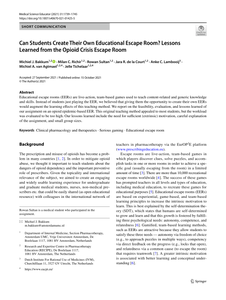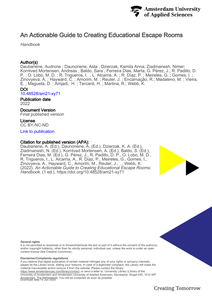Abstract Educational escape rooms (EERs) are live-action, team-based games used to teach content-related and generic knowledge and skills. Instead of students just playing the EER, we believed that giving them the opportunity to create their own EERs would augment the learning efects of this teaching method. We report on the feasibility, evaluation, and lessons learned of our assignment on an opioid epidemic-based EER. This original teaching method appealed to most students, but the workload was evaluated to be too high. Our lessons learned include the need for sufcient (extrinsic) motivation, careful explanation of the assignment, and small group sizes.
MULTIFILE

Digital educational escape rooms (DEERs) can provide an engaging gamified learning experience for students that is easy to use and sustainable for teachers. Though well-established in the STEM fields, where escape rooms often call for students to apply procedural skills, escape rooms are also used across a range of subjects to impact durable skills and attitudes such as communication, collaboration, and critical thinking. This paper seeks to extend the application of DEERs into social entrepreneurship (SE) education by exploring the DEER design elements relevant to the SE field. This paper will focus on developing durable skills and attitudes associated with social entrepreneurship, an area of entrepreneurship that seeks to create businesses with positive social impact. To identify the relevant design elements in DEERs, we conducted a systematic literature review. The research question was "Which design elements of digital educational escape rooms are necessary to teach social entrepreneurship skills and competencies?” This current paper builds on this type of framework by highlighting the relationship between the components of a DEER and learning objectives, specifically those relevant to a social entrepreneur’s educational context. For example, almost all papers reported successful collaboration in online groups. The authors also found that specific puzzle types were less important than the gamified context on impact on learning and skill development. Thus, the authors contribute to our understanding of how DEERs can relate to SE specific learning objectives, skills, and attitudes.
DOCUMENT
Educational escape rooms (EERs) are increasingly used in education as learning innovations for non-digital and game-based learning (GBL) since EERs positively influence student motivation. They are common in educational fields where skills developments are vital such as STEM subjects and healthcare. However, EERs are marginally implemented in entrepreneurship education (EE) because there is a lack of evaluated design elements to guide the creation of EER in this context, which hampers their wider adoption. Therefore, in this study, we evaluated design elements for EERs in EE. We are particularly concerned with experiential EE since EERs are well suited for experiential learning. We used a research-through-design approach and created an EER based on 11 design elements derived from the literature on social cognitive theory, entrepreneurship competence, and gamification. We created and evaluated the EER in two cycles with two diverse groups of students at a university of applied sciences in the Netherlands. We contribute to the literature and practice of experiential EE by presenting evaluated design elements for EERs. We show which design elements work well and which do not. We also present a comprehensively designed EER that educational professionals can implement in their experiential EE programs.
DOCUMENT

This paper aims to present a systematic literature review on state-of-the-art Educational Escape Rooms (EERs) with the use of digital technologies. More specifically, the focus of the study is to present the current developments and trends concerning Digital Educational Escape Rooms (DEERs) and investigate how they foster learning outcomes for online learners. Additionally, the present study provides insights into the design process of such technology enhanced EERs. This review is attributed to identifying and covering research gaps since the current literature has focused on the pedagogical aspects of Escape Rooms (ERs) in education, but no studies seem to have been conducted in regard to the pedagogical implications of Digital Escape Rooms (DERs) in educational environments. Based on the exhaustive literature review, an agenda for future research is promised and the implications for designing innovative ER approaches have been highlighted. The anatomy of the fundamental components of conducting systematic literature reviews was followed. The results of the review could be addressed to multidisciplinary teams related to education, game researchers, educational researchers, faculty members, scholars, instructors, and protagonists of educational systems to encourage them to thoroughly study the core elements of DEERs and how they can be applied in virtual educational contexts to facilitate students’ learning achievements.
DOCUMENT

The UNLOCK project - Creativity through game-based learning at higher education – aims to equip HEIs to design, set and facilitate escape room games in their learning experiences, to foster the creativity and other entrepreneurial skills of HEI’s students.The UNLOCK project will provide the context, process and tools based on a new and innovative learning approach that stimulates entrepreneurial skills in both students and educators, aiming at strengthening employability, creativity and new professional paths.
DOCUMENT

The following e-book was prepared as part of the Erasmus+ UNLOCK project, which has the objective of identifying the use of educational escape rooms (EERs) in higher education environments and examining the role of educators in those activities. The document presents a review of the existing body of academic literature on EERs, while capturing current approaches and practices from across the diverse line of disciplines, and challenges experienced in the adoption of EERs in the (higher) education settings. The literature review provides an overview of the status-quo of the EERs in the higher education sector, followed by UNLOCK project partner country reports (Denmark, Germany, Netherlands, Lithuania, Portugal, and Spain) for targeted insights on the adoption of EERs in the local (higher) education contexts. We also present the synthesis report provides a discussion of the major findings, along with emerging themes and recommendations for further EER research and practice.
DOCUMENT

In the last years we have observed a growing interest in the use of gamification approaches for climate change education. While most practices are related to digital gaming, there is a new trend which is still academically unexplored: escape rooms. The main objective of this paper is to serve as an initial exploratory study in this field by identifying and analysing climate change-related escape rooms. For that purpose we carried out a web search and a qualitative content analysis. A total of 17 initiatives are described and compared, unravelling their main audience, country of origin, topics, scenarios and objectives covered. The paper also highlights what escape rooms can offer to climate change education: experiential and immersive learning, problem solving and critical thinking skills, and a sense of collaboration and urgency.
DOCUMENT

Introduction: Given the complexity of teaching clinical reasoning to (future) healthcare professionals, the utilization of serious games has become popular for supporting clinical reasoning education. This scoping review outlines games designed to support teaching clinical reasoning in health professions education, with a specific emphasis on their alignment with the 8-step clinical reasoning cycle and the reflective practice framework, fundamental for effective learning. Methods: A scoping review using systematic searches across seven databases (PubMed, CINAHL, ERIC, PsycINFO, Scopus, Web of Science, and Embase) was conducted. Game characteristics, technical requirements, and incorporation of clinical reasoning cycle steps were analyzed. Additional game information was obtained from the authors. Results: Nineteen unique games emerged, primarily simulation and escape room genres. Most games incorporated the following clinical reasoning steps: patient consideration (step 1), cue collection (step 2), intervention (step 6), and outcome evaluation (step 7). Processing information (step 3) and understanding the patient’s problem (step 4) were less prevalent, while goal setting (step 5) and reflection (step 8) were least integrated. Conclusion: All serious games reviewed show potential for improving clinical reasoning skills, but thoughtful alignment with learning objectives and contextual factors is vital. While this study aids health professions educators in understanding how games may support teaching of clinical reasoning, further research is needed to optimize their effective use in education. Notably, most games lack explicit incorporation of all clinical reasoning cycle steps, especially reflection, limiting its role in reflective practice. Hence, we recommend prioritizing a systematic clinical reasoning model with explicit reflective steps when using serious games for teaching clinical reasoning.
DOCUMENT

The pace of introduction of new technology and thus continuous change in skill needs at workplaces, especially for the engineers, has increased. While digitization induced changes in manufacturing, construction and supply chain sectors may not be felt the same in every sector, this will be hard to escape. Both young and experienced engineers will experience the change, and the need to continuously assess and close the skills gap will arise. How will we, the continuing engineering educators and administrators will respond to it? Prepared for engineering educators and administrators, this workshop will shed light on the future of continuing engineering education as we go through exponentially shortened time frames of technological revolution and in very recent time, in an unprecedented COVID-19 pandemic. S. Chakrabarti, P. Caratozzolo, E. Sjoer and B. Norgaard.
DOCUMENT
